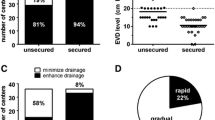Abstract
Background
We examine two accepted methods of managing cerebrospinal fluid (CSF) drainage in patients following subarachnoid hemorrhage (SAH). The first is intermittent CSF drainage when intracranial pressure (ICP) reaches a pre-defined threshold (monitor-first) and the second is continuous CSF drainage (drain-first) at set pressure thresholds. This pilot study is designed to determine if there is a cause for a randomized study of comparing the two methods.
Methods
This prospective observational pilot study enrolled 37 patients with SAH and external ventricular drainage between October 2008 and August 2009. Patients were treated with one of two methods of ICP management (drain-first vs. monitor-first) according to the discretion of the admitting physician.
Results
There were no significant differences in baseline characteristics including age, gender, severity of neurological dysfunction, and radiographic findings between the two groups. The incidence of vasospasm was not different between the drain-first group (66.7%; 16 of 24 patients) and the monitor-first group (53.9%; 7 of 13 patients).
Conclusion
This pilot study was neither powered, nor expected to detect a difference between groups. The results of this study provide support for the design and conduct of a randomized study to assess the impact of two methods of CSF diversion for patients with SAH.
Similar content being viewed by others
References
Bederson JB, Connolly ES, Batjer HH, Dacey RG, Dion JE, Diringer MN, et al. Guidelines for the management of aneurysmal subarachnoid hemorrhage. Stroke. 2009;40:994–1025.
Greenberg MS. Handbook of neurosurgery. 5th ed. Lakeland, FL: Thieme; 2001.
Mack WJ, King RG, Ducruet AF, Kreiter K, Mocco J, Maghoub A, et al. Intracranial pressure following aneurismal subarachnoid hemorrhage: monitoring practices and outcome data. Neurosurg Focus. 2003;14:1–5.
Harrod CG, Bendok BR, Batjer HH. Prediction of cerebral vasospasm in patients presenting with aneurismal subarachnoid hemorrhage: a review. Neurosurgery. 2005;56:633–54.
Claassen J, Bernardini GL, Kreiter K, Bates J, Du YE, Copeland D, et al. Effect of cisternal and ventricular blood on risk of delayed cerebral ischemia after subarachnoid hemorrhage: the Fisher scale revisited. Stroke. 2001;32:2012–20.
Hirashima Y, Kurimoto I, Hayashi N, Umemura K, Hori E, Origasa H, et al. Duration of cerebrospinal fluid drainage in patients with aneurismal subarachnoid hemorrhage for prevention of symptomatic vasospasm and late hydrocephalus. Neurol Med Chir (Tokyo). 2005;45:177–83.
Fisher CM, Kistler JP, Davis JM. Relation of cerebral vasospasm to subarachnoid hemorrhage visualized by computerized tomographic scanning. Neurosurgery. 1980;6:1–9.
Auer LM, Schneider GH, Auer T. Computerized tomography and prognosis in early aneurysm surgery. J Neurosurg. 1986;65:217–21.
Auer LM, Mokry M. Disturbed cerebrospinal fluid circulation after subarachnoid hemorrhage and acute aneurysm surgery. Neurosurgery. 1990;26:804–9.
Kasuya H, Shimizu T, Kagawa M. The effect of continuous drainage of cerebrospinal fluid in patients with subarachnoid hemorrhage: a retrospective analysis 108 patients. Neurosurgery. 1991;28:56–9.
Otawara Y, Ogasawara K, Kubo Y, Sasoh M, Ogawa A. Effect of continuous cisternal cerebrospinal fluid drainage for patients with thin subarachnoid hemorrhage. Vasc Health Risk Manag. 2007;3(4):401–4.
Anderson GB, Ashforth R, Steinke DE, Findlay JM. CT angiography for the detection of cerebral vasospasm in patients with acute subarachnoid hemorrhage. Am J Neuroradiol. 2000;21:1011–5.
Klimo P Jr, Kestle JR, MacDonald JD, Schmidt RH. Marked reduction of cerebral vasospasm with lumbar drainage of cerebrospinal fluid after subarachnoid hemorrhage. J Neurosurg. 2004;100:215–24.
Kwon OY, Kim Y-J, Kim YJ, Cho CS, Lee SK, Cho MK. The utility and benefits of external lumbar CSF drainage after endovascular coiling on aneurismal subarachnoid hemorrhage. J Korean Neurosurg Soc. 2008;43:281–7.
Park IS, Meno JR, Witt CE, Chowdhary A, Nguyen TS, Winn HR, et al. Impairment of intracerebral arteriole dilation responses after subarachnoid hemorrhage. Laboratory investigation. J Neurosurg. 2009;111:1008–13.
Britz GW, Meno JR, Park IS, Abel TJ, Chowdhary A, Nguyen TS, et al. Time-dependent alterations in functional and pharmacological arteriolar reactivity after subarachnoid hemorrhage. Stroke. 2007;38:1329–35.
Deshaies EM, Boulos AS, Popp J. Peri-operative medical management of cerebral vasospasm. Neurol Res. 2009;31:644–50.
Hoefnagel D, Dammers R, Ter Laak-Poort MP, Avezzat CJJ. Risk factors for infections related to external ventricular drainage. Acta Neurochir(Wien). 2008;150:209–14.
Hirashima Y, Hamada H, Hayashi N, Kuwayama N, Origasa H, Endo S. Independent predictors of late hydrocephalus in patients with aneurismal subarachnoid hemorrhage- analysis by multivariate logistic regression model. Cerebrovasc Dis. 2003;16:205–10.
Beer R, Lackner P, Pfausler B, Schmutzhard E. Nosocomial ventriculitis and meningitis in neurocritical care patients. J Neurol. 2008;255:1617–24.
Acknowledgments
We are grateful to Nina Pluskowski.
Author information
Authors and Affiliations
Corresponding author
Rights and permissions
About this article
Cite this article
Kim, G.S., Amato, A., James, M.L. et al. Continuous and Intermittent CSF Diversion after Subarachnoid Hemorrhage: a Pilot Study. Neurocrit Care 14, 68–72 (2011). https://doi.org/10.1007/s12028-010-9401-y
Published:
Issue Date:
DOI: https://doi.org/10.1007/s12028-010-9401-y




